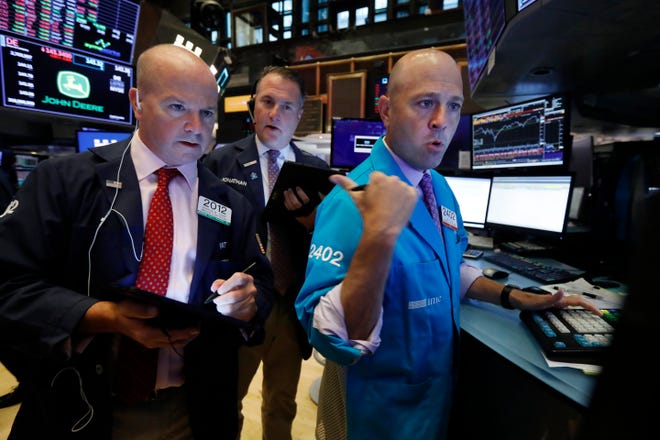
What a difference a few weeks makes.
In late August, stock markets had plunged to nearly three-month lows in the wake of President Donald Trump’s escalating tariff threats against China and tumbling long-term bond yields that signaled a bleak economic outlook.
On Friday, the Dow closed higher for an eighth-straight day – the longest such streak since May 2018 – and third consecutive week. And as hopes build for U.S.-China trade talks next month, the Standard & Poor’s 500 index is less than half a percentage point below its record high close on July 26.
The message? The trade war giveth, and the trade war taketh away.
“Clearly, the market has been very sensitive to any developments in U.S. China trade war,” says Ameriprise Chief Market Strategist David Joy.
Other forces are also at work. The world’s central banks, including the Federal Reserve, are cutting interest rates or enacting other stimulus measures to goose their economies and put a floor under stocks. U.S. consumer spending, the economy’s chief engine, continues to grow solidly. And long-term bond yields have climbed out of the depths, somewhat easing recession fears.
But stock analysts warn that more volatility lay ahead and the market is unlikely to rise significantly above its previous high until the U.S. and China reach a broad resolution of their trade standoff.
Trump fatigue?:Exclusive: Small-business support for Trump ebbs, but experts say he can reclaim voters
“I think we’re going have a tough time getting further without a definitive settlement,” says JJ Kinahan, chief market strategist For TD Ameritrade.
The Dow Jones Industrial Average closed up 37 points Friday at 27,219, while the Standard & Poor’s 500 index dipped 2 points to 3,007. That means both indexes were about 6% above their late August lows and less than 1% off their record highs in July.
So far in 2019, the S&P 500 is up a healthy 20%. That means an investor with $100,000 in a 401(k) plan at the start of the year has seen that nest egg grow to $120,000.
But keep this in mind: The broad stock index is just 2.6% above its year-ago level, meaning wild swings linked mostly to developments in the trade war and Fed interest rate moves have left the market largely treading water.
Here’s a quick rundown of why markets have rebounded:
The trade war
Early last month, Trump tweeted that he would slap new tariffs on $300 billion in Chinese imports, mostly consumer products. Weeks later, he said he’d hike those and earlier tariffs.
But early this month, U.S. and Chinese officials agreed to resume negotiations. And this week, China agreed to lift tariffs on American pork and soybean shipments to that country while Trump delayed tariffs set to take effect Oct. 1.
“By lowering the pressure,” Joy says, the olive branches “give them room to talk.”
Yet in the short term, both Joy and Kinahan expect continued talks that may put off tariffs for several months, calming markets, rather than a deal on thorny issues such as China’s theft of U.S. intellectual property.
The Fed and other central banks
The Fed lowered its key interest rate July for the first time in a decade despite a solid economy to head off a potential recession that could be set off by the trade conflict slowing global growth. It’s expected to approve another quarter-point cut next week. Lower rates spur more borrowing and economic activity and prod investors to move money from low yielding bonds to stocks.
Meanwhile, the European Central Bank on Thursday agreed to further cut its benchmark rate and buy 20 billion euros in bonds each month to push down long-term rates. Other central banks around the globe are similarly trimming rates to jolt sluggish economies. That helps S&P 500 companies, which derive about 40% of their sales from overseas.
Consumer spending
U.S. retail sales had a better-than-expected gain in August after a strong advance in July. Consumption makes up about 70% of economic activity.
Bond yields
The 10-year Treasury bond has risen from 1.45% to 1.9% since early September, calming investors. In August, the 10-year note dipped below two-year Treasury yields, a rare inversion of the yield curve that means investors don’t think the economy and inflation will grow much over the long term. Inversions squeeze the margins of banks, discouraging lending. And since they often foreshadow recessions, they can hurt consumer and business confidence, making a downturn a self-fulfilling prophecy.
Corporate earnings
Third-quarter corporate earnings season kicks off in early October with low expectations. FactSet expects a 3.6% drop in S&P 500 profits compared to a year earlier, a third-straight dip in annual earnings. But as long as the declines are modest, investors will likely chalk them up to trade war-related uncertainty that has dented business investment, Joy and Kinahan say.
And they’ll rely on hopes that a broad trade agreement next year will ratchet both earnings and stocks evidently higher. For now, both analysts expect the S&P 500 to end the year slightly lower, at 2,950.




























